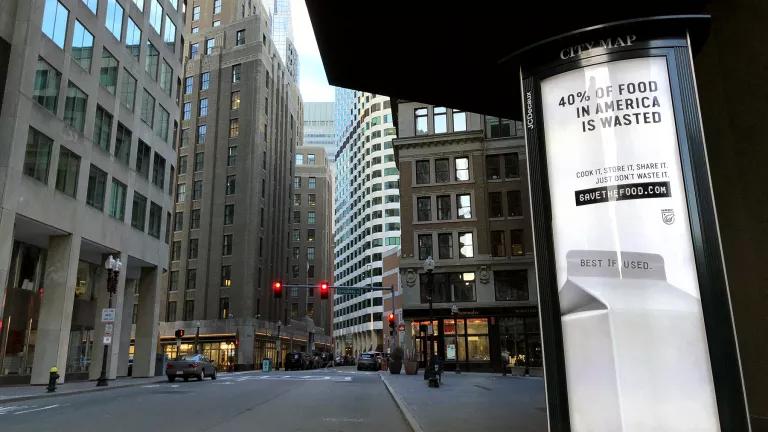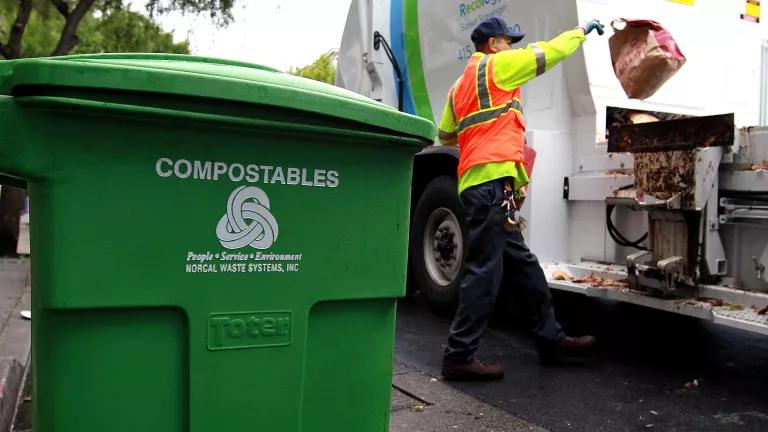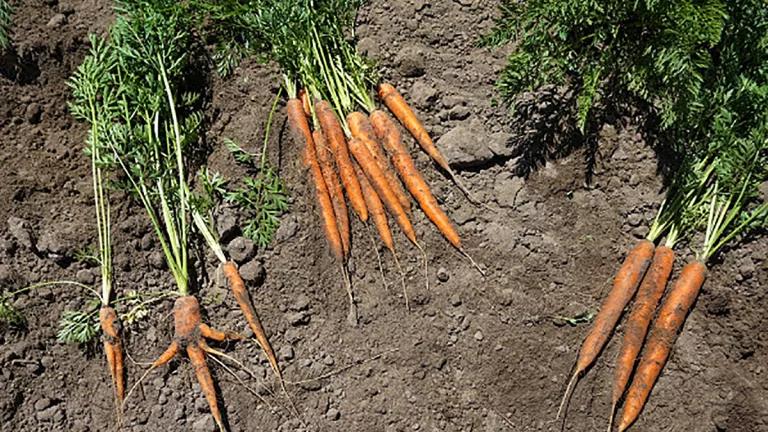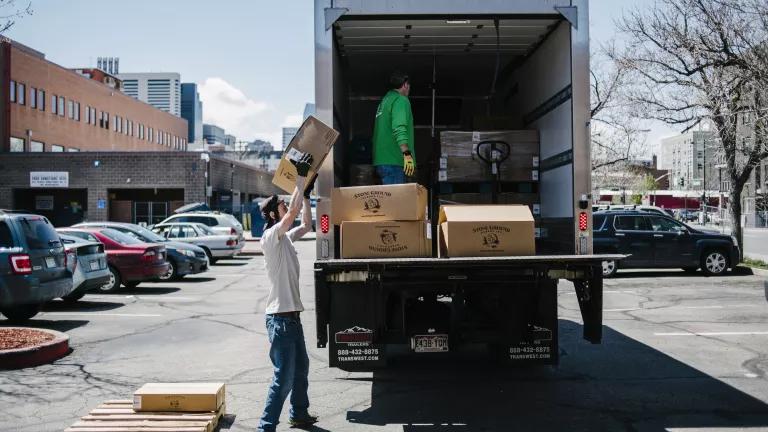Food to the Rescue: Waste Not Orange County Coalition
Building partnerships for food insecurity solutions

Co-authored with Alice Henly, formerly of NRDC
Location
Orange County, CA
Date Started
November 2012
Lead Organization
Waste Not OC Coalition
Organization Type
Public-private partnership
Strategy in a Nutshell
Facilitate the donation and distribution of wholesome surplus food to reduce hunger and divert food from landfills; spur innovation around transportation and chilling of food donations; and build a unique coalition of health and food experts in Orange County
Partners
Orange County Environmental Health Division, Orange County hospitals and other medical care providers, Orange County Food Bank, Second Harvest Food Bank, Food Finders, Yellow Cab Company of Greater Orange County, Childhood Hunger Coalition, food-service industry, and waste hauling firms
Technology/Equipment Used
Google Maps online mapping software
Rescued Food to Date
5,611,731 pounds of food (4,676,442 meals) in 2016 and 6,036,011 pounds of food (5,030,009 meals) from January through July of 20171
GHG Emissions Avoided
11,783 metric tons CO2 equivalent for 20162
The Challenge and Opportunity
On any given day, one in ten people in Orange County, California, or about 315,000 people, including one in six children, are at risk of food insecurity, that is, they lack reliable access to a steady supply of food.3 Meanwhile, Orange County restaurants and grocery stores discard about 330,000 tons of food annually.4 This reflects a nationwide problem: while one in eight Americans are food insecure, a total of $218 billion worth of food is lost or wasted each year across the United States by farms, manufacturers, grocery stores, restaurants, food-service companies, or households.5
While these shocking statistics are becoming more widely known, many communities are ill-equipped to connect public health expertise with food rescue efforts to provide a coordinated strategy for addressing hunger. Health screenings, for example, do not usually address food insecurity concerns. Meanwhile, transportation and refrigeration barriers can limit food donations, and food rescue systems are often inadequately funded to address these challenges.
“Screening individuals at risk for food insecurity is uncommon in most medical offices,” explains Dr. Eric Handler, the Orange County public health officer. “In my forty-plus years as a pediatrician, I have never asked a family if they are facing food insecurity—and part of the reason is that, if they said, ‘Yes,’ then what was I going to do? We didn’t have something in place to help them.”6
To help address this problem, Handler began looking for a way to bridge the gap between medical professionals, health and safety specialists, food providers, and food banks. He started with a single question: “If we were able to capture food that is wasted and direct it to people in need, could we end hunger in Orange County?” When Orange County Food Bank Director Mark Lowry replied with a “Yes,” Handler and Lowry decided to form and lead Waste Not OC Coalition, a public-private partnership focused on stopping food insecurity by connecting local organizations.
Recipe for Success
Handler and Lowry launched Waste Not OC in November 2012 with the goal of ending hunger in Orange County by bringing together community experts from diverse backgrounds to better rescue and distribute wasted food.
“We brought a coalition together representing the food industry, public health, food banks, private organizations, the health department, food safety, and charities—everyone that we could think of,” explains Handler. The coalition uses a multipronged approach to address hunger. This approach includes: creating tools to facilitate food donations and educate the community; pursuing innovative partnerships to overcome transportation challenges for donated food; identifying food insecure individuals; and connecting those individuals to food sources.
Increase Food Donations and Community Awareness: Waste Not OC discovered that a majority of food establishments were not donating food because they mistakenly assumed that health departments would discourage food donations for food safety and liability reasons.
“There has been a huge education gap about liability,” says Lowry. “But, in fact, restaurants’ non-liability for donated food is guaranteed by law.”
“We partner with county-based environmental health specialists that conduct health inspections,” explains Handler. “They dispel myths about any liabilities connected to donating food. We provide a one-page sheet that says, ‘Under the Good Samaritan Act, you’re not held liable if you prepare and handle the food correctly and donate it in good faith.’ We reinforce that it’s OK to donate food—here’s how to do it, and we’re behind you.”
Waste Not OC Coalition sought to bridge the gap between the health department and food-related businesses. With time, Orange County health inspectors became champions for food donation and started educating businesses on how to safely donate food without fear of liability. In addition, Waste Not OC started to follow up with businesses after health inspector visits to help identify food donation opportunities. Importantly, Waste Not OC members spoke the language of food businesses and other potential donors, and thus were able to advance food donation efforts by connecting them with valuable contacts in the Waste Not OC network.
To increase food donations, Waste Not OC established goals to reach specific food collection targets and engage potential new donors. To help achieve these goals, Food Finders, Second Harvest Food Bank, and the Orange County Food Bank, all 501c3 nonprofit entities, and members of the Waste Not OC Coalition work with hundreds of volunteers to transport surplus food from food-producing facilities, such as restaurants, hospitals, and other businesses, to food shelters. Waste Not OC has also systematically conducted outreach in the cities of Anaheim and Orange and across the county to connect businesses with national food recovery organizations. Finally, to expand the network of food distributors across the region, Waste Not OC works with Food Finders to ensure that new pantries receive recovered food each quarter.
Since its inception in 2012, Waste Not OC Coalition members have partnered with more than 200 agencies and pantries and more than 400 businesses, food distributors, health care agency employees, and volunteers. The strength and breadth of those partnerships is beginning to pay off, and food donation in Orange County is expanding rapidly. In the first half of 2017 alone, Waste Not OC recovered 3,000 tons of surplus food, which amounts to approximately 5 million meals for food insecure members of the community, a significant increase since 2016.7
Develop Innovative Solutions to Overcome Food Transportation Barriers: Food rescue efforts often encounter difficulty arranging transportation and chilling for donated food, especially food that becomes available late at night. Nonprofit organizations often have limited staff available to pick up food donations from late-night events at large venues or restaurants. In addition, some venues may lack sufficient cold storage space to hold the food overnight and so have to discard it instead.
In keeping with its strategy of forming unique partnerships, Waste Not OC partnered with the Yellow Cab Company of Greater Orange County to pick up and deliver food to school sites and other nonprofit partners, often late at night, when many nonprofits do not have capacity. Yellow Cab contributes vehicles and drivers during idle hours, free of charge, to deliver food donations. Drivers donate their time and the company contributes to gas costs.
“Our taxis also pick up donated excess food from Waste Not OC partners and deliver the perishables to the local pantries and food shelters,” Yellow Cab says on its website. “We get to still do what we love every day, while helping our community during non-peak ride times. Waste Not OC is an outstanding program and Yellow Cab of Greater Orange County is proud to be associated with the effort to end hunger in our community.”8 To recognize the partnership, Yellow Cab taxis display the Waste Not OC seal on their vehicles.
To alleviate any concerns about mishandled food, all donations are packaged carefully (in coolers when necessary) and are handled only by trained staff at the donating business and recipient pantry. All deliveries are within county limits and are delivered immediately after pickup to retain freshness. The cabs use Waste Not OC’s Google map of more than 230 food pantries in Orange County (described in greater detail below) to minimize delivery time and optimize their routes to the closest food pantries. The cabs are also inspected and certified every two weeks for cleanliness by the Yellow Cab company. More than 500 cabs bear the Waste Not OC partner seal to promote their contribution to ending hunger.
Identify Food Insecure Individuals: To better identify and help food insecure individuals, Waste Not OC, distributes a screening tool for health professionals, including Children's Hospital of Orange County, public health nurses, social services agencies, health centers, and family resource centers. Partnering with the Childhood Hunger Coalition (a Waste Not OC coalition member), Waste Not OC developed a guide to help doctors identify food insecure patients.
The Children's Hospital of Orange County was the first to use the food insecurity screening tool, which consists of two questions:
- Is the following statement often true, sometimes true, or never true for your household? Within the past 12 months, we worried whether our food would run out before we got money to buy more.
- Is the following statement often true, sometimes true, or never true for your household? Within the past 12 months, the food we bought just didn’t last and we didn’t have money to get more.
The screening questions help quickly identify households with young children at risk for food insecurity. Families identified as food insecure are then referred to a nearby pantry identified using Waste Not OC’s Google map.
To address the relationship between food insecurity and health, Dr. Handler also developed a set of standard practices for all community clinics to consider. For clinics with food storage capacity, these practices include providing on-site emergency food for immediate assistance to food insecure patients.
Waste Not OC also worked to get food insecurity screening added to the American Academy of Pediatrics’ list of top 10 priorities for 2015. Waste Not OC also gave presentations on the importance of food insecurity screening at high-profile national conferences, including the National Environmental Health Association Annual Educational Conference, the National Association of County and City Health Officials Annual Conference, and the American Public Health Association Annual Meeting.
Increase Food Access: To help increase food access, Waste Not OC created a variety of resources to connect hospitals with local food pantries. First, to make better use of existing infrastructure, Waste Not OC developed a Google map of more than 230 food pantries in Orange County, a tool that helps provide food to food insecure individuals.9 Using this map, medical professionals can swiftly refer their patients to food sources. For example, Orange County Family Resource Centers and the Children’s Hospital of Orange County have integrated the food insecurity screening tool into their electronic health records and regularly use Waste Not OC’s interactive Google map. Between December 2014 and July 2015, the Children’s Hospital of Orange County successfully screened 16,703 patients and provided resources to the 555 identified as food insecure.
Waste Not OC also partnered with 2-1-1 Orange County, an online, national social services phone directory, to combine food pantry databases. 2-1-1 Orange County now hosts pantry information on its own directory as well as on the Waste Not OC Google map of pantries to reach a wider audience. This extensive food pantry database includes addresses, phone numbers, eligibility, language access, refrigeration capabilities, website addresses, and hours of operation. 2-1-1-Orange County has also started working on a mobile app that will make it easier still to learn about and gain access to Orange County’s food pantries.
“Our vision of providing simple resources to address inadequate access to food can be applied not only to Orange County, but to any county, city, or state in the nation,” says Handler. “Currently, Los Angeles and San Diego counties are looking to replicate our activities. Waste Not OC’s free online toolkit consists of a few documents, which can be replicated as a feasible starting point for any county in the country.”10 Waste Not OC distributed food donation information to more than 2,500 Orange County businesses between July 2014 and March 2015, while helping secure donation of more than 61 tons of food in the same period.
“The solution to food insecurity lies in triaging responsibilities across programs in the county health department, private businesses, nonprofits, other organizations, and individuals,” says Lowry.
Waste Not OC has also added 30 pantries to its list of organizations that receive rescued food from food recovery agencies, helping to connect more local businesses with surplus food to people in need. A total of 130 businesses throughout the cities of Anaheim, Orange, and Tustin donate regularly to pantries, and the list continues to grow.
Looking ahead, Waste Not OC aims to establish a network of food recovery kitchens throughout Orange County devoted to repurposing or repackaging bulk donations into nutritious prepared meals for donation. Waste Not OC also plans to establish a culinary training program to help troubled youth develop valuable skills while preparing meals for those in need. Finally, Waste Not OC plans to expand donation outreach to more colleges and universities, and to support the development of college food pantries.
Look for creative partners to help fill food recovery and donation resource gaps. From the Yellow Cab Company of Greater Orange County to 2-1-1 Orange County, Waste Not OC draws on valuable resources from a wide range of creative partners. Instead of investing in building new capacity, partnering with local institutions with existing resources can provide a more affordable and faster solution. These partnerships can be facilitated by engaging municipalities and the food industry.
Connect public health and environmental health professionals to draw on expertise from both fields. “Connect the silos, not the dots,” recommends Handler. “Environmental health was running in its own silo, and education about the value of food donation was our key challenge right up front. We drew on [the expertise of] health and safety professionals to alleviate concerns and educate businesses. It was crucial to have other credible voices at the table. Admittedly, when you go outside of your silo, a project can get messier, but you will find more creative and effective solutions in the long run.”
Establish a project manager from the onset. “If you don’t have a project manager in the beginning, you will not be successful,” says Handler. “You need the glue across all of the different organizations that you’re bringing together to connect the coordinator for the food recovery, pediatrician champion, governmental agency champion.”
Train food recovery volunteers to alleviate businesses’ concerns about risk to their brands. We found that some companies… [did not donate food] because of the liability they perceived for their brand image,” says Lowry. To alleviate these concerns about brand liabilities among partner businesses, Waste Not OC instituted a Food Rescue Enhanced Safe Handling certificate to ensure all volunteers are trained and equipped to handle food safely.
Reinforce the economic value to business partners. To encourage food donations, it is important to educate local businesses and organizations about the benefits of donating surplus food. These benefits include identifying opportunities to reduce wasted food and improve operations, saving waste management costs, and receiving tax benefits.

Focus on health. The Orange County Health Department, Waste Not OC’s government entity partner, came from a health and hunger relief perspective to this collaboration. It is important to recognize that keeping good food from going to waste has multiple benefits and can often come from efforts focused on improving access to healthy food for those that need it. Incorporating a health perspective from the outset can result in more comprehensive and robust solutions to both food waste and hunger relief.
Facilitate partnerships. Waste Not OC’s extensive partnership network was a critical component in the success of this initiative. Cities can establish a similar coalition of partners to address food insecurity and increase food donations. Cities can also help connect stakeholders with opportunities to engage and contribute their expertise and services.
Focus on addressing food insecurity. The Waste Not OC Coalition has established an integrated infrastructure to connect food insecure individuals and families with high-quality, healthy food sources. Waste Not OC has also empowered medical professionals and raised awareness to address food insecurity. This focus on family health helps ensure that children can get healthy food to grow and thrive.
Waste Not OC’s vision is to end hunger in Orange County through food recovery, food distribution, training, and education. Its mission is to meet the nutritional needs of the community and protect the environment by facilitating the donation and distribution of wholesome surplus food. Waste Not OC is a public-private partnership that includes the Orange County Health Department, the Orange County Food Bank, Second Harvest Food Bank, Food Finders, and private industry partners.
Founded in 1989, Food Finders is a multiregional food bank and food rescue organization based in Lakewood, CA. Its mission is to eliminate hunger and food waste while improving nutrition in the food insecure communities it serves. Food Finders picks up donated food from hundreds of local grocery stores, bakeries, restaurants, and produce markets and distributes it directly to missions, shelters, and social service agencies. Three hundred Food Finders volunteers and staff drivers pick up and deliver food on the same day. Food Finders helps provide an average of 21,000 meals a day, reducing both food insecurity and food waste in Southern California.11 During its 28-year history, Food Finders has rescued more than 130 million pounds of food. Its goal for 2017—one it is on track to accomplish—is to collect 9 million pounds of food.12 As a community-based food rescue organization, Food Finders aims to serve as a conduit for food, education, and awareness between donors, volunteers, agencies, and people in need.

1. Waste Not OC Coalition, https://www.wastenotoc.org/.
2. Based on calculation using the EPA Waste Reduction Model (WARM) Version 14. https://www.epa.gov/warm/versions-waste-reduction-model-warm#WARM Tool V14.
3. Feeding America, Food Insecurity in Orange County, http://map.feedingamerica.org/county/2015/overall/california/county/orange.
4. Terence Loose, “Putting Food on the Table Instead of Into the Trash,” Orange County Register, December 2015, http://www.foodfinders.org/wp-content/uploads/2015/12/Putting-Food-on-the-Table-Instead-of-Into-the-Trash.pdf.
5. Dana Gunders,NRDC, Wasted: How America Is Losing up to 40 Percent of its Food from Farm to Fork to Landfill, 2017, https://www.nrdc.org/sites/default/files/wasted-2017-executive-summary.pdf.
6. Vimeo, Waste Not OC promo, https://vimeo.com/121322863.
7. Waste Not OC Coalition, https://www.wastenotoc.org/ (July 31, 2017).
8. Yellow Cab of Greater Orange County, http://www.yellowcab.com/blog/yellow-cab-greater-orange-county-proudly-supports.
9. http://www.wastenotoc.org/#!providing-food-resources/c22p0.
10. Waste Not OC Coalition, The Facts to Know When Donating Food, http://dpw.lacounty.gov/epd/roadmap/pdf/Toolkit_WNOC_061015.pdf.
11. Food Finders, http://www.foodfinders.org/.
12. Orange County Community Foundation, Food Finders, https://www.ocnonprofitcentral.org/profile/1140468/food-finders-inc/.





